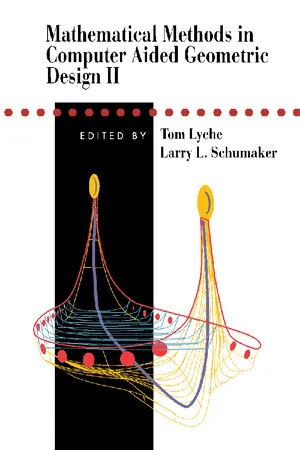
- 644 pages
- English
- PDF
- Available on iOS & Android
Mathematical Methods in Computer Aided Geometric Design II
About This Book
Mathematical Methods in Computer Aided Geometric Design II covers the proceedings of the 1991 International Conference on Curves, Surfaces, CAGD, and Image Processing, held at Biri, Norway. This book contains 48 chapters that include the topics of blossoming, cyclides, data fitting and interpolation, and finding intersections of curves and surfaces. Considerable chapters explore the geometric continuity, geometrical optics, image and signal processing, and modeling of geological structures. The remaining chapters discuss the principles of multiresolution analysis, NURBS, offsets, radial basis functions, rational splines, robotics, spline and Bézier methods for curve and surface modeling, subdivision, terrain modeling, and wavelets. This book will prove useful to mathematicians, computer scientists, and advance mathematics students.
Frequently asked questions
Information
Table of contents
- Front Cover
- Mathematical Methods in Computer Aided Geometric Design II
- Copyright Page
- Table of Contents
- PREFACE
- PARTICIPANTS
- Chapter 1. Symmetrizing Multiaffine Polynomials
- Chapter 2. Norm Estimates for Inverses of Distance Matrices
- Chapter 3. Numerical Treatment of Surface–Surface Intersection and Contouring
- Chapter 4. Modeling Closed Surfaces: A Comparison of Existing Methods
- Chapter 5. A New Characterization of Plane Elastica
- Chapter 6. POLynomials, POLar Forms, and InterPOLation
- Chapter 7. Pyramid Patches Provide Potential Polynomial Paradigms
- Chapter 8. Implicitizing Rational Surfaces with Base Points by Applying Perturbations and the Factors of Zero Theorem
- Chapter 9. Wavelets and Multiscale Interpolation
- Chapter 10. Decomposition of Splines
- Chapter 11. A Curve Intersection Algorithm with Processing of Singular Cases: Introduction of a CHpping Technique
- Chapter 12. Best Approximations of Parametric Curves by Splines
- Chapter 13. An Approximately Cubic Surface Interpolant
- Chapter 14. On the Continuity of Piecewise Parametric Surfaces
- Chapter 15. Stationary and Non-Stationary Binary Subdivision Schemes
- Chapter 16. MQ–Curves are Curves in Tension
- Chapter 17. Offset Approximation Improvement by Control Point Perturbation
- Chapter 18. Curves and Surfaces in Geometrical Optics
- Chapter 19. Evaluation and Properties of the Derivative of a NURBS Curve
- Chapter 20. Hybrid Cubic Bézier Triangle Patches
- Chapter 21. Modelling Geological Structures Using Splines
- Chapter 22. Wonderful Triangle: A Simple, Unified, Algorithmic Approach to Change of Basis Procedures in Computer Aided Geometric Design
- Chapter 23. An Arbitrary Mesh Network Scheme Using Rational SpUnes
- Chapter 24. Bézier Curves and Surface Patches on Quadrics
- Chapter 25. Monotonicity Preserving Interpolation Using Rational Cubic Bezier Curves
- Chapter 26. Minimization of Interpolating Spline Curves with Bounded Derivatives
- Chapter 27. On Piecewise Quadratic Approximation and Interpolation
- Chapter 28. Non-affine Blossoms and Subdivision for Q-Splines
- Chapter 29. On a Class of Data Parametrizations: Variations on a Theme of Epstein, II
- Chapter 30. Wavelets and Image Compression
- Chapter 31. Lower Bounds on the Dimension of Bivariate Spline Spaces and Generic Triangulations
- Chapter 32. Geometrie Contact of Order ρ Between Two Surfaces
- Chapter 33. On Non-Parametric Constrained Interpolation
- Chapter 34. Tensor Product Slices
- Chapter 35. Construction of Smooth Surfaces by Piecewise Tensor Product Polynomials
- Chapter 36. The Virtues of Cyclides in CAGD
- Chapter 37. Simple Surfaces Have No Simple C1 Parametrization
- Chapter 38. Some Tools for Quasi-Interpolation on Cardinal Grids
- Chapter 39. Discrete Bézier Curves and Surfaces
- Chapter 40. Rational Geometrie Curve Interpolation
- Chapter 41. Curvature Properties of Parametric Triangular Bézier Patches
- Chapter 42. Offsets of Polynomial Bezier Curves: Hermite Approximation with Error Bounds
- Chapter 43. Representing Piecewise Polynomials as Linear Combinations of Multivariate B-Splines
- Chapter 44. An Explicit Derivation of Discretely Shaped Beta-spline Basis Functions of Arbitrary Order
- Chapter 45. Discrete Convolution Schemes
- Chapter 46. A Method for Removing the Singularities from Gregory Surfaces
- Chapter 47. Bivariate Spline Approximation by Penalized Least Squares
- Chapter 48. Interpolation with g-splines